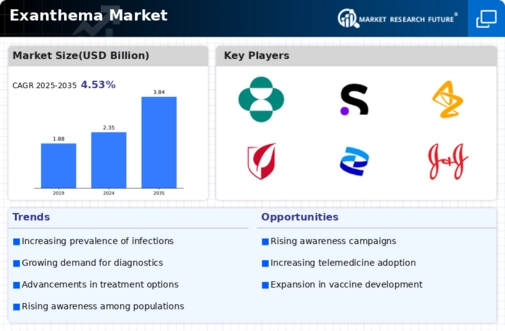Rising Incidence of Exanthema Cases
The increasing incidence of exanthema cases, particularly among children, appears to be a primary driver for the Exanthema Market. Data indicates that viral infections, such as measles and rubella, have seen a resurgence in certain regions, leading to heightened awareness and demand for effective treatments. This trend is likely to stimulate growth in the market as healthcare providers seek to address these outbreaks. Furthermore, the rise in travel and migration patterns may contribute to the spread of these infections, thereby increasing the need for preventive measures and therapeutic options. As a result, pharmaceutical companies are focusing on developing vaccines and antiviral medications, which could further enhance the market landscape.
Growing Demand for Telehealth Services
The growing demand for telehealth services is reshaping the Exanthema Market. As patients increasingly seek remote consultations, healthcare providers are adapting their services to meet this need. Telemedicine offers a convenient platform for diagnosing and managing exanthema cases, particularly in areas with limited access to healthcare facilities. This shift not only improves patient engagement but also allows for more efficient resource allocation. Moreover, the integration of telehealth into routine care may lead to earlier detection and treatment of exanthema, potentially reducing the severity of outbreaks. As telehealth continues to gain traction, its impact on the Exanthema Market is likely to expand.
Advancements in Diagnostic Technologies
Technological advancements in diagnostic tools are significantly influencing the Exanthema Market. The development of rapid diagnostic tests and molecular techniques has improved the accuracy and speed of diagnosing exanthema-related conditions. This progress not only facilitates timely treatment but also enhances patient outcomes, thereby driving market growth. For instance, the introduction of point-of-care testing devices allows for immediate results, which is crucial in managing outbreaks. Additionally, the integration of artificial intelligence in diagnostic processes may further streamline operations and reduce costs. As healthcare systems increasingly adopt these innovations, the demand for related products and services in the Exanthema Market is expected to rise.
Focus on Patient Education and Awareness
A heightened focus on patient education and awareness is emerging as a critical driver in the Exanthema Market. Public health campaigns aimed at informing communities about the signs, symptoms, and prevention of exanthema are becoming increasingly prevalent. This emphasis on education is essential for early detection and treatment, which can mitigate the spread of infections. Furthermore, healthcare providers are utilizing various platforms, including social media and community outreach, to disseminate information effectively. As awareness grows, patients are more likely to seek medical attention promptly, thereby driving demand for diagnostic and therapeutic options in the Exanthema Market. This trend underscores the importance of proactive health management in combating exanthema-related diseases.
Increased Investment in Vaccine Development
The surge in investment for vaccine development is a notable driver within the Exanthema Market. Governments and private entities are allocating substantial resources to research and develop vaccines targeting exanthema-causing pathogens. This trend is particularly evident in the wake of rising infection rates, prompting a proactive approach to immunization. For example, the World Health Organization has emphasized the importance of vaccination campaigns, which has led to increased funding and collaboration among stakeholders. As new vaccines enter the market, they are likely to enhance public health initiatives and reduce the burden of exanthema-related diseases. Consequently, this investment trend is expected to bolster the overall market.





















Leave a Comment